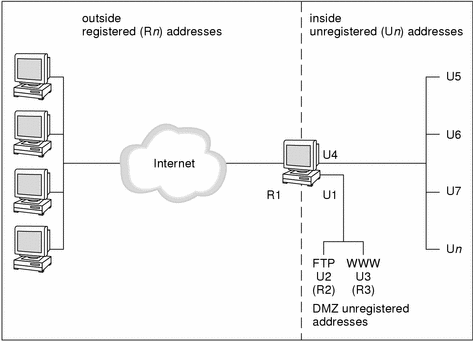Example Two
Registered addresses are necessary for advertised kinds of resources, such as publicly accessible servers on your network; consequently, these machines must be at well-known, fixed addresses. Because a host must have a registered address before it can communicate over public networks, machines that host public resources either must have stable registered addresses, or their unregistered (internal) addresses must translate to stable registered addresses. The following scenarios illustrate how a demilitarized zone (DMZ), an internal network with limited public access, could use registered addresses or unregistered addresses with network address translation.
Scenario 1: DMZ Uses Registered Addresses
In the figure below, the Screen, in routing-mode, uses Q1 as its own IP address on the external network interface. It has a DMZ network with registered addresses R1 through R8 on a second interface. The Screen (Q1) and the servers in the DMZ (the FTP server, R2, and the WWW server, R3), have routable registered addresses on the public network that allow them to communicate with any other machine with a registered address. The Screen uses the remaining registered addresses (R4 through R8) for NAT.
Figure 7-1 Scenario 1: Static and Dynamic NAT

The Screen uses dynamic NAT to translate the addresses in its unregistered address range (U2-Un) to the remaining addresses in its registered address range (R4-R8). When an internal host with an unregistered address tries to connect to an external host with a registered address, the Screen assigns the internal host a registered address to use for the duration of the network communication session.
Scenario 2: DMZ Uses NAT Addresses
The figure below illustrates an organization that has a network consisting of a large number of unregistered addresses (Un) and a set of eight registered addresses (R1-R8). Hosts on the inside network must be able to communicate through the Screen with external hosts.
Figure 7-2 Scenario 2: Static and Dynamic NAT

In the figure above, the Screen is connected to the public network R1-R8. R1 is its IP address on the public network interface. It uses static NAT to translate the unregistered DMZ addresses of the FTP server (U2) and the WWW server (U3) to the registered (public) addresses R2 and R3. The private addresses U4 through Un will be translated dynamically to the registered addresses R4 through R8. Because the IP addresses of the servers and the internal network are translated to routable registered addresses, they can communicate with any other registered address.
The Screen uses dynamic NAT to translate the addresses in its unregistered address range (U4-Un) to the remaining addresses in its registered address range (R4-R8). When an internal host with an unregistered address tries to connect to an external host with a registered address, the Screen assigns the internal host a registered address to use for the duration of the network communication session.
This scenario has the advantage that if you change ISPs, you do not have to re-address all the hosts on your internal registered network.
- © 2010, Oracle Corporation and/or its affiliates
